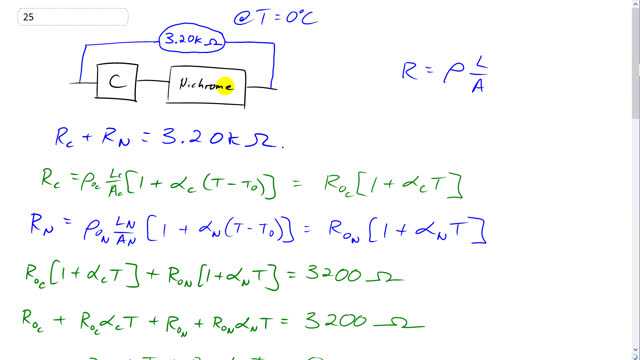
For some applications, it is important that the value of a resistance not change with temperature. For example, suppose you made a - resistor from a carbon resistor and a Nichrome wire-wound resistor connected together so the total resistance is the sum of their separate resistances. What value should each of these resistors have (at ) so that the combination is temperature independent?

In order to watch this solution you need to have a subscription.
This is Giancoli answers with Mr. Dychko. So, at zero degrees Celsius this combined resistance of the carbon and the Nichrome resistors or is 3.2 kilo ohms and this combination resistance is supposed to be temperature independent. So that means when the temperature goes up we want the combined resistance of these two things to still be 3.2 kilo ohms and that's possible because carbon and Nichrome have opposite signs to their coefficient of resistivities… the temperature coefficient of resistivities. For carbon, it's negative something or like negative point 0.0005 whereas for Nichrome, it's positive 0.0004. So because they're opposite signs they can you know as temperature goes up the carbon has a reduction in this resistance whereas the Nichrome has an increase in its resistance. And the idea being that the amount of resistance in increase of the nichrome equals the amount of resistance decrease of the carbon so that their total still remains 3.2 kilo ohms. Okay. So the sum of the resistance is 3.2 kilo ohms. The resistance of the carbon in terms of temperature is the resistivity of carbon at… at its original temperature, zero degrees Celsius times the length of the carbon wire divided by its cross-sectional area. N I'm just substituting from here into there that we're going to quickly turn this whole thing into whatever resistance it has originally which is the whole question we have to figure out what that is. R naught c and we're going to multiply that by one plus the temperature coefficient of resistivity for carbon times T minus T naught but T naught is zero degrees Celsius. And so we'll just read this as R naught c times one plus Alpha c T and same story for the Nichrome, ‘N’ for Nichrome here, it's resistivity of Nichrome at the original temperature times its length divided by its cross-sectional area which is all resistance of the Nichrome at the original temperature and that's times one plus Alpha N times T minus T naught which is zero, so we'll just write R naught N end times one plus temperature coefficient of resistivity for Nichrome times the final temperature. Whatever the final temperature is and then… which turns out it will just cancel anyway. Which is good. So. Here is the resistance of the carbon, from here and plus the resistance of the nichrome has a total 3200 ohms. And we can multiply through into the brackets here and we have resistance originally of the carbon wire plus the original resistance times the temperature coefficient of resistivity multiplied by the final temperature plus the resistance of the nichrome originally plus the… you know, R naught N times Alpha N Times T, multiplying through by that, equals 3200 ohms and then this and this are the original resistances of the carbon and the nichrome and that totals 3200 ohms. So if you subtract that from both sides you get zero on the… on the right side and those terms disappear from the left. So we're just left with R naught c times Alpha C times T plus R naught N times Alpha N times T equals zero. And we can divide everything by T and that just completely disappears because zero divided by T on the right is still zero and then take this term to the right side making it... I guess I took this one to the right side. Take that one to the right side making it a negative and then divide it by Alpha N and you solve for the original resistance of the Nichrome wire, which of course you can't solve because you don't know what the original resistance of the carbon was but we'll get there. We'll turn our attention to a different formula which is this one that we've seen before. So the total resistance is 3200 ohms and we'll substitute for the Ni… the Nichrome resistance. and it is R naught c times Alpha C over Alpha N and it's negative. So that's why I gave a minus there and that equals 3200 ohms so we have an equation with only one unknown. The original resistance of the carbon wire. So, we factor that out and this times one plus Alpha C over Alpha N equals 3200 ohms and then it's good for him to write it as a single fraction. So make it, Alpha N minus Alpha C, all over Alpha N and then multiply by Alpha N and divided by Alpha N minus Alpha C on both sides and you get the original resistance of the carbon wire is Alpha N times 3200 ohms divided by Alpha N minus Alpha C and then plug in numbers and you get, 0.0004 temperature coefficient of resistivity for nichrome times 3200 Ohms divided by 0.0004 minus the negative 0.0005 temperature coefficient of resistivity for carbon. And this works out to 1420 ohms is the original resistance of the carbon wire and the resistance of the nichrome wire is gonna be 3200 ohms minus the resistance of the carbon wire, just you know, rearranging this a little bit. And that's 3200 ohms minus 1422.22 ohms which works out to 1780 ohms as the original resistance of the nichrome wire and these resistances will change with temperature. But the point is that their total will not change.